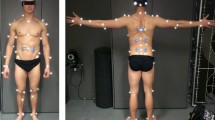Abstract
Studies describing the movement patterns, relative contributions and kinematic characteristics of the lumbar spine and hip present conflicting results. Differences could be due to sample characteristics, methodological issues and descriptive methods. The purpose of this study was to describe the amount and pattern of lumbar spine and hip movement during flexion and return using a range of kinematic and temporal variables. Our aim is to gain a more complete picture of movement patterns taking place at the hip and lumbar spine in asymptomatic individuals. Ultimately the development of a normative database of movement patterns will help to clarify comparative movement interpretation in patients with lumbar back pain. This study analysed lumbar spine and hip motion in group of young healthy males (n = 20) during the flexion and return movement. A motion analysis system captured continuous movement profiles in the sagittal plane. Each participant performed five trials of flexion and return. The angular and velocity data were averaged and used for statistical and descriptive analysis. The kinematic and temporal variables distinguishing statistically significant differences in the lumbar spine and hip movement patterns are not the same for the flexion and return movement. However, within this group four (20%) demonstrated a pattern angular change between the lumbar spine and hip which was different from the other participants. Even within a healthy group of participants individual differences exist in the lumbar spine and hip movement patterns during flexion and return.




Similar content being viewed by others
Notes
Motion Analysis™ Motion Analysis Corporation, CA, USA
References
Burton AK, Tillotson KM, Troup JDG (1989). Variation in the lumbar sagittal mobility with low-back trouble. Spine 14:584–590
Esola MA, McClure PW, Fitzgerald GK, Siegler S (1996) Analysis of lumbar spine and hip motion during forward bending in subjects with and without a history of low back pain. Spine 21:71–78
Farfan HF (1975) Muscular mechanism of the lumbar spine and the position of power and efficiency. Orthop Clin N Am 6:135–144
Jayaraman G, Nazre AA, McCann V, Redford JB (1994) A computerized technique for analysing lateral bending behaviour of subjects with normal and impaired lumbar spine. A pilot study. Spine 19:824–832
Keller TS, Szpalski M, Spengler DM, Hayez JP (1993) Interpretation and parameterization of dynamic trunk isoinertial movements using an ensemble-averaging technique. Clin Biomech 8:220–222
Kippers V, Parker AW (1984) Posture related to myoelectric silence of erectores spinae during trunk flexion. Spine 9:740–745
Lee RYW, Wong TKT (2002) Relationship between the movements of the lumbar spine and hip. Hum Mov Sci 21:481–494
Lund T, Nydegger T, Schlenzka D, Oxland TR (2002) Three-dimensional motion patterns during active bending in patients with chronic low back pain. Spine 27:1865–1874
Marras WS, Ferguson SA, Gupta P, Bose S, Parnianpour M, Kim JY, Crowell RR (1999) The quantification of low back disorder using motion measures: methodology and validation. Spine 24:2091–2100
Marras WS, Parnianpour M, Ferugson SA, Kim JY, Crowell RR, Simon SR (1993) Quantification and classification of low back disorders based on trunk motion. Eur J Phys Med 3:218–235
Marras WS, Parnianpour M, Ferguson SA, Kim JY, Crowell RR, Bose S, Simon SR (1995) The classification of anatomic- and symptom-based low back disorders using motion measure models. Spine 20:2531–2546
Marras WS, Wongsam PE (1986) Flexibility and velocity of the normal and impaired lumbar spine. Arch Phys Med Rehab 67:213–217
Mayer TG, Smith SS, Keeley J, Mooney V (1985) Quantification of lumbar function: part 2. Sagittal plane trunk strength in chronic low back pain patients. Spine 10:765–772
McClure PW, Esola M, Schreier R, Siegler S (1997) Kinematics analysis of lumbar and hip motion while rising from a forward flexed position in patients with and without a history a low back pain. Spine 22:552–558
Nelson JM, Walmsey RP, Stevenson JM (1995) Relative lumbar and pelvic motion during loaded spinal flexion/extension. Spine 20:199–204
Paquet N, Malouin F, Richards CL (1994) Hip-spine movement interaction and muscle activation patterns during sagittal trunk movements in low back pain patients. Spine 19:596–603
Pearcy M, Portek I, Shepherd J (1985) The effect of low back pain on lumbar spinal movements measured by three-dimensional X-ray analysis. Spine 10:150–153
Pearcy M, Shepherd J (1985) Is there instability in spondylolisthesis? Spine 10:175–177
Porter JL, Wilkinson A (1997) Lumbar-hip flexion motion. A comparative study between asymptomatic and chronic low back pain in 18- to 36-year-old men. Spine 22:1508–1514
Sahrmann SA (2002) Diagnosis and treatment of movement impairment syndromes. Mosby, St. Louis
Shum GL, Crosbie J, Lee RY (2005) Symptomatic and asymptomatic movement coordination of the lumbar spine and hip during an everyday activity. Spine 30:E697–E702
White AA, Panjabi MM (1990) Clinical biomechanics of the spine, 2nd edn. J.B. Lippincott Company, Philadelphia
Wong TK, Lee RY (2004) Effects of low back pain on the relationship between the movements of the lumbar spine and hip. Hum Mov Sci 23:21–34
Acknowledgments
We thank Dr. Allan B. Carman, Mr Bruce Knox, School of Physiotherapy, University of Otago for their technical assistance.
Author information
Authors and Affiliations
Corresponding author
Rights and permissions
About this article
Cite this article
Pal, P., Milosavljevic, S., Sole, G. et al. Hip and lumbar continuous motion characteristics during flexion and return in young healthy males. Eur Spine J 16, 741–747 (2007). https://doi.org/10.1007/s00586-006-0200-2
Received:
Revised:
Accepted:
Published:
Issue Date:
DOI: https://doi.org/10.1007/s00586-006-0200-2




